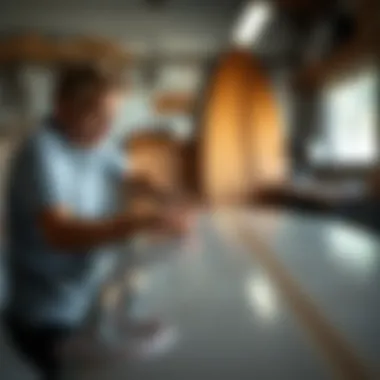Ultimate Guide to Top Surfboard Ding Repair Kits


Intro
Surfing is not merely a sport; it’s an exhilarating lifestyle that demands respect—both for the waves and for the gear that helps you conquer them. Every wave you ride has the potential to come with its own set of challenges, often resulting in unsightly dings on your beloved surfboard. These imperfections, if left unattended, can undermine performance and ruin your surfing experience.
Enter ding repair kits—your surfboard’s best friend after a mishap. The right repair kit can mean the difference between smoothly gliding over the waves and battling unwanted leaks or structural damage that could sideline you for weeks. Whether you’re a seasoned pro or a fresh-faced beginner, understanding the essentials of surfboard repair is crucial.
In this guide, we’ll delve into the components that make up the best ding repair kits, the effective methods for using them, insights from real users, and a look at popular brands within the market. By the end, you’ll feel equipped to choose a kit tailored to your surfing style and board type, ensuring you won’t miss out on any gnarly waves.
Let’s ride the wave of knowledge and get started!
Preface to Ding Repair Kits
In the realm of surfing, dings, or damage to your surfboard, are more common than one might think. As riders take on waves and navigate through the ocean, it's not unusual for boards to face a few bumps and scrapes. This is where a ding repair kit comes into play. Having the right toolkit to address these issues can mean the difference between a day spent mending equipment and a day riding all those sweet swells.
Understanding Dings and Their Impact on Performance
Dings come in various shapes and sizes, from tiny nicks to deep cracks that compromise the structural integrity of the board. Each type of ding can greatly affect the board’s performance. For example, a small crack might not seem like a big deal, but if water seeps in, it can lead to significant damage, like delamination. The performance alteration is not just a minor inconvenience; it can completely change how a board handles in the water, affecting speed, maneuverability, and responsiveness. So, understanding the nature of dings is crucial for any surfboard owner. If your board has a ding, ignoring it or postponing a repair can lead to further damage and higher repair costs down the road.
The Necessity of a Reliable Repair Kit
A reliable ding repair kit is not merely a convenience; it’s an essential component of surfboard maintenance. When you’re far from a surf shop or in a remote area, having your own kit allows you to tackle repairs on the spot. Think about this: nothing is worse than gearing up for a session only to discover a ding. With a good repair kit, you're empowered to fix it quickly and get back in the water.
Consider what goes into a quality repair kit: the right materials like epoxy or polyester resins, sandpaper for smoothing out repairs, and applicators for even distribution. Each element in the kit plays its part in ensuring that you can effectively mend your board, prolong its lifespan, and maintain peak performance when you're out on the waves. Plus, many kits come with instructions designed for easy use, making it accessible for both novices and seasoned surfers.
Components of a Ding Repair Kit
Understanding the components of a ding repair kit is crucial for maintaining the longevity and performance of your surfboard. A well-equipped repair kit can save you time, money and ensure that you’re ready for the waves at a moment’s notice. The effectiveness of repairs greatly relies on the quality and type of materials and tools you choose, making this knowledge indispensable.
Types of Materials Used
Epoxy Resins
Epoxy resins are a favorite among many surfboard repair enthusiasts. The main draw is their exceptional bonding strength. Unlike other materials, epoxy offers superior durability, making it ideal for fixing those pesky dings that can affect your board’s performance.
Another characteristic that stands out is its resistance to water and impact. When properly cured, epoxy creates a strong barrier, preventing moisture from seeping into the board and potentially causing further damage. Their longer drying time can be seen as a disadvantage, but that time is rewarding. Slower curing means a more thorough chemical bonding, leading to a stronger repair.
Key benefits of using epoxy resins include:
- Longevity: Repairs tend to last much longer without reverting to their original damage state.
- Versatility: Suitable for a variety of surfboard materials, especially modern constructions.
Polyester Resins
Polyester resins are more commonly found in budget options, and their popularity springs from their quick curing times and ease of use. Known for creating a strong bond, these resins are often favored for minor repairs or quick fixes before hitting the surf.
A unique feature of polyester is its compatibility with fiberglass cloth, which can create a cohesive repair. However, there are some trade-offs. While they are cheaper and set fast, they are generally not as durable when compared to epoxy. They can also be more susceptible to moisture absorption if not applied with care.
Advantages include:
- Cost-effective: An accessible option for those not looking to spend much on repairs.
- Quick drying: Ideal for surfers who don't have time to spare before their next session.
Fiberglass Cloths
Fiberglass cloths are an essential part of most ding repair kits. They reinforce the repair by providing much-needed structural support. When applied with resin, they create a solid patch that is crucial for areas that have been significantly compromised.
The lightweight nature of fiberglass means it can strongly bond with minimal added weight to the surfboard. A key characteristic is its versatility; fiberglass comes in various weights, allowing you to choose based on the severity of the damage you’re repairing.


With fiberglass, the main advantages are:
- Strength: Adds durability to repairs, making them less prone to future cracking.
- Lightweight: Helps maintain the board’s performance profile after repairs are made.
Essential Tools for Repairs
Sandpaper Types and Uses
Sandpaper plays a vital role in the prep work, smoothing the damaged area for better adhesion of epoxy or polyester. Having the right grit for different stages is also important. Start with a coarser grit to sand away rough edges, and finish with a fine grit to create a smooth surface for repair application.
The distinct types of sandpaper give you opportunities to tailor your technique.
- Coarse grit (40-60) can remove material and create a rough surface for better adhesion.
- Medium grit (80-120) is for smoothing out the surface, prepping it nicely for a final layer of resin.
Choosing the right sandpaper enhances the effectiveness of your repair process immensely.
Applicators and Spreading Tools
Using proper applicators helps achieve an even application of the resin, which is crucial for a successful repair. Applicators can come in various forms—brushes, spatulas, or rollers—each with a unique purpose. Brushes can reach into cracks, while spatulas allow you to spread the resin evenly.
The smoothness of your repair largely hinges on the applicators you choose.
- Flexibility is key, as some repairs may require reaching curved surfaces or tight spots.
- Durability: Look for applicators that can withstand chemical interactions with your chosen resin.
Mixing Tools
Mixing tools, such as cups and sticks, ensure proper ratios when combining resin and hardener. If not mixed correctly, the repair can fail before it starts. Accurate measurements and a thorough blend are fundamental for robust repair work.
Using dedicated mixing tools can prevent contamination and ensure consistency in each batch you prepare.
- Prevent cross-contamination by keeping your mixing tools separate.
- Ease of use: Look for clear measurement indicators on mixing cups to simplify the process.
Evaluating Different Repair Kits
When it comes to choosing a ding repair kit for surfboards, the evaluation process is crucial. Not all kits are created equal, and selecting the right one can significantly impact the repair's efficiency and longevity. This section aims to illuminate the important criteria and brand insights to consider in your decision-making process. By understanding what separates a mediocre kit from a stellar one, you arm yourself with knowledge that can lead to successful repairs and ultimately enhance your surfing experience.
Criteria for Selection
Ease of Use
Ease of use stands out as a vital criterion when selecting a ding repair kit. When you’re out enjoying the surf, the last thing you need is a complicated kit that requires an engineering degree to understand. A user-friendly kit not only saves time but can drastically reduce the frustration that often comes with DIY repairs.
The prime characteristic of ease of use is its intuitive setup. Kits that come with clear instructions or even video tutorials are often preferred. Imagine that you’re ready to repair, and you can follow a step-by-step guide without scratching your head. A perfect blend of simplicity and effectiveness usually defines a popular choice in this category.
In terms of unique features, some kits aim at novices, including pre-measured components or one-step applications. This minimizes the potential for errors—a considerable advantage for first-time users. On the other hand, if the setup is overly basic, it may lack options for more complex repairs, which could be a disadvantage for experienced surfers seeking more control.
Bonding Strength
The bonding strength of the materials used in the ding repair kit is a key aspect to consider. A repair that boasts excellent bonding strength ensures that your surfboard will be back in action quicker and more effectively. A strong bond contributes directly to the longevity of the repair, meaning you won’t be back at square one after just a few rides.
In evaluating bonding strength, look for the ability of the adhesive material to withstand not just water, but also vibrations and impacts. High-strength resins are usually a favored choice because they tend to offer exceptional resilience. However, too strong a bond can be a double-edged sword. If you need to redo or alter the repair later on, a robust bond could complicate matters or even cause further damage.
Drying Time
Drying time is another significant aspect. A repair that takes an eternity to cure might not suit someone who’s eager to hit the waves again after a mishap. Therefore, it's essential to get a kit that balances speed with durability. Generally, a quick-drying option that doesn't compromise the strength of the bond is ideal.


What’s unique about drying time considerations is that some formulations cure instantly under UV light, while others can take several hours. The convenience of a fast-drying product is evident, especially if you plan to repair on the go. However, it's also crucial to consider that some fast cures may not offer the same level of thoroughness as slower-setting products.
Brand Comparisons
Navigating the plethora of options can be overwhelming, and this makes brand comparisons fundamentally valuable. Recognizing the strengths and weaknesses of various brands can help you make an informed choice.
Popular Brands Overview
When we talk about popular brands, these often have a dedicated following and a reputation built on reliability and performance. Names like QUILLA SURF REPAIR and HURLEY, for instance, have established themselves due to their consistent quality and effective formulations.
The key characteristic of these brands lies in their trustworthiness; each has fine-tuned their offerings based on user feedback over the years. Popular brands usually benefit from extensive research and development, thus pushing out tailored solutions that cater specifically to surfer needs.
However, while many popular brands are reliable, it’s essential to examine reviews, as they can differ in performance based on the specific kit. Sometimes the hype doesn’t match reality, especially for newcomers to surfing.
User Feedback and Ratings
Finally, user feedback and ratings shed light on real-life experiences that cannot always be gleaned from the product descriptions. Ratings can be a goldmine of information; they provide insight into how well the kits perform under various conditions and the long-term effectiveness of the repairs.
User feedback serves as a testament to the unique features of specific kits. Whether it’s ease of use, bonding strength, or curing times, seeing how others fared can guide your choice. High ratings usually indicate a solid kit, but mixed reviews invalidate the idea that one size fits all. Dead battery testimonies or comments on service quality can also be helpful.
The unique converting factors also include location and surfing conditions these users have faced, as a kit suitable for calm waters may not work well in rough seas. Thus, a closer look at feedback tailored to your own surfing environment can aid substantially.
Repair Techniques for Dings
Repair techniques are an essential component of maintaining the integrity and performance of surfboards. When a ding occurs, it can lead to a compromise in buoyancy and maneuverability. Proper repair techniques not only restore the physical appearance but also ensure that the board lasts longer in the unpredictable surf conditions. This section delves deep into the crucial steps involved in successfully repairing dings, providing surfboard enthusiasts the knowledge to handle repairs with confidence.
Surface Cleaning and Preparation
Before diving into any repair work, surface cleaning and preparation hold significant importance. The success of a repair job hinges on how well the damaged area is prepped before applying the repair material. Cleaning the ding removes dirt, wax, and moisture. A cleaner surface allows for better adhesion of the repair materials, reducing the risk of future delaminating or water intrusion.
To start:
- Clear the Area: Use a soft cloth to wipe away any visible sand or debris around the damage.
- Wash with Soapy Water: A mild soap solution can effectively rid the surface of residues without leaving behind harmful chemicals.
- Dry Thoroughly: Make sure the surface is completely dry before moving onto the next steps. You can use compressed air or a towel for this.
It’s advisable not to rush this process. Investing a bit of time to prepare will pay off in the durability of your repair. As the saying goes, "A stitch in time saves nine."
Applying Epoxy vs. Polyester
When it comes to choosing between epoxy and polyester resins, each has its own set of advantages. Understanding these can make a world of difference in the effectiveness of the repair.
Epoxy is known for its superior bonding capabilities and water resistance, making it an excellent choice for high-performance boards. It tends to cure to a very strong bond, which is ideal if you frequently hit rough waters. However, working with epoxy can be a bit tricky as it requires precise mixing of components and sometimes a longer curing time.
On the other hand, polyester is more accessible and often more affordable. It’s simpler to use and cures more quickly, which can be a huge advantage for those looking to get back in the water in a hurry. But it may not offer the same level of protection against water ingress, particularly in heavier damage scenarios.
Choosing the right type is influenced not only by the kind of ding but also by individual preferences. For light dings, polyester may do the trick, while more significant damage could merit the robust nature of epoxy.
Finishing Touches for a Smooth Surface
After applying your chosen resin, the final step involves finishing touches to achieve a smooth, professional-looking repair. This stage is often overlooked, yet it determines how well the repair blends with the rest of the board. Here are some steps to follow:
- Sanding: Once the resin cures according to instructions, sand the repaired area using medium-grit sandpaper, then progress to fine-grit for a silky finish. Be gentle to avoid damaging the surrounding area.
- Compounding: After sanding, use a compound which can help restore the gloss and create a seamless transition between the repair and the original board surface.
- Polishing: A final polish can protect against UV damage and give your repair a clean, shiny look.
With these finishing touches, your repair not only enhances performance but also elevates the overall aesthetic of your surfboard.
"A good repair is not just about fixing but bringing the board back to life, ensuring every session on the waves is as enjoyable as the first."


Maintaining these repair techniques will ensure your surfboards remain in top-notch condition while providing a reliable experience on the waves. For further detailed discussions on surfboard maintenance, resources such as Britannica and community forums like Reddit can provide valuable insights.
Case Studies of Repair Success
Understanding how ding repair kits work in practice can be incredibly insightful for surfboard enthusiasts. Reading about others' experiences can illuminate the effectiveness and reliability of different repair kits. These case studies not only highlight successful repairs but also underline the real-world challenges faced by surfers in maintaining their boards in optimal condition. Insights gained from these scenarios can help guide readers to make informed decisions about which repair kits to choose.
User Experiences in Different Scenarios
Many surfboarders have shared their journeys through the repair process, each tale uniquely showcasing various kits and techniques in diverse environments. For instance, Mark, a seasoned surfer from California, described a particularly harsh session where his board took a nasty hit from a rock, resulting in a significant ding. He opted for a polyurethane repair kit, citing its ease of use and quick drying time as crucial factors. After a few hours, the repair not only sealed the ding but also restored the board's aesthetics, allowing Mark to get back on the water the next day.
Similarly, Carmen, a surf school instructor, shared her experience with a fiberglass repair kit after a student accidentally dropped a board. The ding was extensive, but with a little bit of patience and craftsmanship, Carmen managed a successful repair in one afternoon. She emphasized that having good lighting and a comfortable workspace drastically improved her results. These stories offer reassurance that, with the right tools and knowledge, even the worst dings can be effectively tackled.
Before and After Comparisons
Visual comparisons of repairs serve as a powerful testament to the capabilities of various kits. Many surfers take to social media platforms like Reddit or Facebook, exhibiting their repair results through before-and-after photos. Such visual proof illustrates the transformation from damaged to restored, highlighting the significance of a quality repair kit.
For example, John from Hawaii posted a striking side-by-side comparison of his board on a surfing forum. On the left, the board bore an ugly gouge from a surfboard collision, while on the right, after using a two-part epoxy kit, the ding was nearly imperceptible. John noted how crucial it was to follow the instructions meticulously, which contributed to the nearly flawless finish.
These comparisons not only demonstrate the effectiveness of the kits used but also inspire confidence among readers considering repairs. The visible difference can motivate even the most hesitant surfers to take action, empowering them with the knowledge that repair success is attainable.
By gathering these experiences, we grasp a fuller picture of what’s possible when it comes to surfboard maintenance. For more information and user discussions, check out resources on Reddit here or explore general surfing tips at Wikipedia.
Maintenance and Prevention Strategies
Engaging in regular maintenance and employing effective prevention strategies is critical for any surfboard enthusiast. Just like a surfboard is more than just a piece of foam and fiberglass, it also embodies a connection to the ocean, adventure, and personal expression. Without proper care, dings and dents can mar this experience, impacting performance and safety in the water. Understanding how to maintain your board, recognize early signs of wear, and implement protective measures makes all the difference in its longevity and usability.
Regular Inspections for Early Detection
Dings often hide beneath the surface, just waiting for the right moment to impact your ride. that’s why regular inspections are paramount. The first step is to visually examine your board after every session. Look for cracks or soft spots, especially around the tail and nose, where impacts are common.
- Light Pressure Check: Gently press areas that seem suspicious; soft spots usually indicate delamination, which can cause bigger issues if left unchecked.
- Use a Damp Cloth: Wipe the board down; a damp cloth can help reveal cracks that may have been missed initially.
- Immediate Report: If you spot anything unusual, document it with photos; this not only helps track wear over time but also assists during repairs.
Keeping your board in top condition is an ongoing process. Encourage fellow surfers around you to adopt this habit—camaraderie in the surf community fosters more awareness about board maintenance.
Protective Measures Against Dings during Surfing
Some might say that prevention is better than cure, and this rings true for surfboards. Taking precautionary measures can save you time, money, and unnecessary grief down the line. Here are a few practical strategies:
- Board Bags are Your Best Friends: Invest in a sturdy board bag; it cushions your board from dings during transport and storage. Look for bags with adequate padding and materials designed for durability.
- Use Leashes Wisely: Ensure that your leash is in good condition. A broken leash not only risks losing your board but can also cause damage to your surfboard if it strikes you or another surfer.
- Avoiding Crowded Breaks: Surfing near novice surfers can be risky; their erratic movements might unintentionally lead to direct impacts on your board. Whenever feasible, seek out less crowded waves where you can ride without concern.
- Fins and Outfitting Care: Regularly check fins to ensure they’re secure and undamaged. Loose components can lead to bigger problems when caught in a wave or during wipeouts.
"An ounce of prevention is worth a pound of cure"—this is especially true in surfing where a proactive approach can prolong the lifespan of your board and improve your experience riding the waves.
Implementing these habits not only protects your surfboard, but fosters a deeper appreciation for the craftsmanship that goes into making each ride possible. By addressing repairs quickly and practicing prevention strategies, you ensure your board remains in the best shape to ride those waves with confidence.
The End and Final Recommendations
In wrapping up our exploration of ding repair kits, it becomes apparent that the right kit is not just a handy tool but a cornerstone of maintaining a surfboard's performance and lifespan. Understanding the different components and repair techniques is crucial not only for extending the life of your surfboard but also for perfecting your time on the waves. By investing in a solid repair kit, surfers can easily tackle dings, thus preventing minor damages from evolving into big headaches.
Summary of Key Insights
Throughout our discussion, several key points have emerged:
- Ding Types: Recognizing various ding types and their effects on performance is essential. Dings can lead to water seepage, which compromises buoyancy and can severely impact riding enjoyment.
- Kit Components: The materials and tools included in a ding repair kit can greatly influence its usability. For instance, epoxy resins are often favored for their durability in harsh conditions, while polyester may suit different needs.
- Repair Techniques: Proper techniques in cleaning, applying, and finishing repairs are just as important as having the right kit. Fumbling in these areas can do more harm than good.
- User Feedback: Insight from fellow surfers and reviews can guide one towards the most reliable brands and effective products, helping to navigate the often overwhelming options available.
This knowledge arms surfers with the tools—and confidence—necessary for DIY repairs, ultimately enhancing their surfing experience.
Choosing the Best Kit for Your Needs
Selecting the best ding repair kit boils down to understanding your specific needs and surfing habits. Here are a few points to consider:
- Surfboard Material: Pay attention to what your board is made of. Different materials will require different repair approaches, impacting the type of kit you should choose. For example, a foam board might need a different mix than a composite board.
- Level of Use: If you're a casual surfer, a basic kit might suffice. For more serious surfers who hit the water regularly, a more comprehensive kit is a wise investment.
- Reputation and Reviews: Look for kits with strong user feedback. Recommendations from fellow surfers, forums, and sites like Reddit can provide insight into what works.
- Cost vs. Value: While higher price tags often reflect quality, there are gems in every price range. It’s about finding the best value for your specific needs without breaking the bank.















